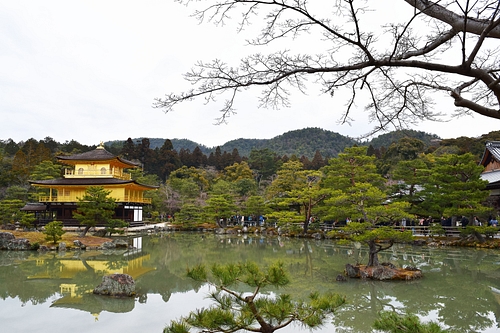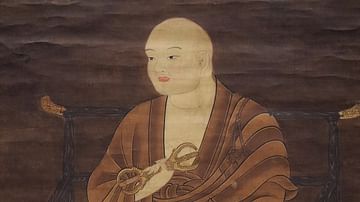
Kinkakuji Temple in Kyoto, Japan, more formally referred to as Rokuon-ji or 'Deer Garden Temple' and otherwise known as 'The Temple of the Golden Pavilion', was first built in 1397 CE. Originally the retirement residence of the shogun Ashikaga Yoshimitsu (r. 1368-1394/5 CE), it was converted into a Rinzai Zen Buddhist temple following Yoshimitsu's death in 1408 CE, a function it still performs today. Kinkakuji was designated by UNESCO as a World Heritage Site in 1994 CE and is an official National Special Historic Site of Japan and listed as a Special Place of Scenic Beauty.
Ashikaga Yoshimitsu
The temple, located in the hilly Kitayama district of north-west Kyoto (formerly known as Heiankyo) was conceived as the retirement retreat for the shogun Ashikaga Yoshimitsu (l. 1358-1408 CE). The shogun acquired the land from the statesman Saionji Kintsune, who had built his own villa on this site of outstanding natural beauty. The new palace complex, which boasted 13 buildings, was completed in 1397 CE and the shogun took early retirement in 1394/5 CE in order to pursue the arts in his vast new home. Ashikaga Yoshimitsu became a great patron of the arts, and Kinkakuji saw a flourishing of such crafts as sword-making and ceramics. The site also saw the birth of Noh theatre. Collectively, all of these artistic endeavours became known as Kitiyama Culture.
Ashikaga Yoshimitsu may have retired but he continued to pull the strings of Japanese government, and he attracted many illustrious visitors to his retreat, notably Emperor Gokomatsu (r. 1392-1412 CE). The former shogun had made it known that he wished, upon his death, for the site to be converted into a Rinzai Zen Buddhist temple, which it was in 1408 CE. The temple was then renamed Rokuon-ji after Rokoun-in-den, the former shogun's posthumous religious title, with its first abbot being Muso-kokushi.
The Golden Pavilion
The Golden Pavilion is so called because it is lavishly covered in gold foil. There is an association between gold and Pure Land Buddhism where the former is considered to represent spiritual purity. Further, the Buddhist paradise is thought to abound with gilded pavilions. Kukai (774-835 CE), the celebrated scholar monk and saint who founded Shingon Buddhism once said, "There are no fixed heavens and hells. If you do good, gold and silver pavilions immediately appear" (quoted in Dougill, 2017, p. 115). Unkind commentators suggest the ostentatious covering might also have something to do with Ashikaga Yoshimitsu's high opinion of himself and a wish to demonstrate his great wealth; he did, after all, receive letters from the Ming Dynasty Emperor as 'the king of Japan', even after he had retired as shogun. The Golden Pavilion is the only surviving building from the original 14th-century CE estate.

The pavilion is an interesting mix of three distinct Japanese architectural styles. The first or ground floor is in the palace architectural style (shinden-zukuri) of the Heian period (794-1185 CE). This floor has a front viewing area, verandah, and rear fishing deck while its walls are of plain wood and white plaster. Inside is a large reception area and statues of both Buddha and a seated Ashikaga Yoshimitsu wearing priest's robes. The middle floor is in the buke-zukuri or samurai residential style and has a space for meetings, the Buddha Hall. The hall contains a shrine to Kanon, the Bodhisattva of mercy and compassion and the ceiling and walls are decorated with painted birds, clouds, and musical instruments. The third and top floor has the bell-shaped windows which are typical of the Zen architectural style, zenshu-butsuden. Both the second- and third-floor exteriors are built of lacquered wood covered with gold leaf, while the interior of the third floor is given the same lavish decoration. Originally containing a statue of Amida and 25 bodhisattvas, the top floor now houses sacred relics of the Buddha. The top floor gives an admirable view of Mt. Kinugasa.
The roof of the pavilion has a pyramid form and is today covered in shingles of hinoki wood but it once had gilded Chinese tiles to match the sheen of the upper two stories. The roof apex has a bronze figure of a phoenix, a symbol of divine favour, virtue, and harmony. The bird fortuitously survived the devastating 1950 CE fire because it was being repaired at the time. The whole shimmering Golden Pavilion is reflected in the waters of the adjacent pond garden, the Kyokochi Pond, which was originally filled with lotus plants and so the whole scene was designed to represent the Buddhist vision of paradise.
Restorations
The Golden Pavilion managed to survive the ravages of the Onin War (1467-1477 CE), although other buildings at the complex were destroyed. It was less fortunate in the fire of 1565 CE and, after being rebuilt in the 19th century CE, there was another blaze in 1950 CE, this one deliberately set off by a disgruntled novice monk, which totally destroyed the building. The latter tragedy was captured in literature in the Temple of the Golden Pavilion (Kinkakuji), a 1956 CE novel by Mishima. In the book, the priest is driven to destroy the pavilion because of its perfection: "When people concentrate on the idea of beauty, they are, without realising it, confronted with the darkest thoughts that exist in this world" (quoted in Dougill, 2017, p114). Painstakingly restored to its former glory, the Golden Pavilion was ready for visitors again from 1955 CE. In 1984 CE the Golden Pavilion was spruced up and three years later given an extra-thick layer of gold foil to make it even more gold than ever before.
The Gardens
The gardens and pine woods at Kinkakuji are a fine example of the landscapes of the Muromachi Period (1333-1573 CE) which invite the walker to explore winding paths that open into constantly shifting perspectives of the gardens as a whole. As in other such gardens built by the Japanese aristocracy, many areas were specifically designed to recall famous landscape scenes from Japanese and Chinese literature. An example is the line of four stones in the Kyokochi Pond which represent the famous image of four boats sailing off to the mythical Isles of the Immortals. The larger of the complex's two ponds also has ten islands, the biggest of which is contoured to represent Japan. There are two freshwater springs which feed the ponds and are used in the tea ceremonies on the site. One of these, the Ryumon Taki (Carp Rock), has a large pointed stone on which the water falls, and this represents the carp in Chinese legend which attempts to climb a waterfall in order to become a dragon. The legend is taken as a metaphor for a monk's struggle to achieve enlightenment.
Dotted around the gardens are many stones, selected and donated by supporters of the temple's founder for their aesthetic qualities and often given names and particular histories. There are several additional buildings, too, such as the abbot's residence, the Sekkatei Teahouse ('Place of Evening Beauty') which was built in the Edo period (1603-1868 CE) and the temple hall which contains a 9th-century CE statue attributed to Kukai. The figure, appropriately enough, is of Fudo-myo (aka Acala) who is a Buddhist deity and considered the chief protector of shrines and temples.
This content was made possible with generous support from the Great Britain Sasakawa Foundation.






